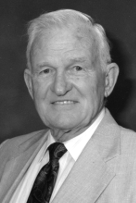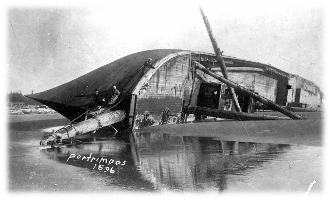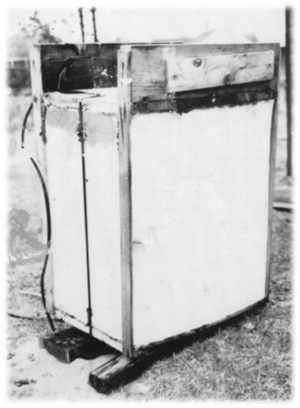|
|
|
|
|
 |
 |
|
Over the waves of time the waters of Southwest Washington and Northwest Oregon have captured an untold number of lives – some remembered in diaries, dusty newspaper files and passing tales, and some forgotten in the cobwebs of passing years.
|
|
|
|
|
About this Book and Author
Wayne O’Neil (Author of Man and the Sea) arrived on the Long Beach (Washington) peninsula in 1930, when his father James O’Neil settled the family there. James took over publishing the Chinook Observer in 1937; as a young boy, Wayne apprenticed in the printing trade. After graduating high school he served in the U. S. Coast Guard during World War II which increased his interest in area marine happenings. Upon returning home, he worked for the family business and began collecting local historical information and photos. He and his wife, Frances, bought the family newspaper and print shop in 1963.
 Two years later, one of the hundreds of shipwrecks occurring on the rough waters of the Columbia River Bar, provided not only an incentive, but also the materials for a book on shipwrecks which Wayne had been thinking about for a number of years. As a photographer, and a journalist, he had been on-scene many times as ships grounded off the Peninsula. Two years later, one of the hundreds of shipwrecks occurring on the rough waters of the Columbia River Bar, provided not only an incentive, but also the materials for a book on shipwrecks which Wayne had been thinking about for a number of years. As a photographer, and a journalist, he had been on-scene many times as ships grounded off the Peninsula.
The story began on January 24, 1965. The captain of the freighter Hawaiian Planter crossing the rough river bar bound from Portland to Hawaii reported to Coast Guard Station Cape Disappointment that he had lost a load of paper stock overboard near Buoy 4, and after making the report, the ship continued on for Hawaii. The Chinook Observer article noted “nine pallets of the paper bobbed in the surf and arrived on Long Beach tide Monday...” When the paper pallets began showing up in the surf off Long Beach, dozens of people raced to the beach to find out what was in the refrigerator-size containers.
The Observer report continued: “The paper stock shipment was on wooden pallets bound with steel tape each containing from 1,500 to 1,700 pounds, and each bundle was addressed to Honolulu; name of the paper company was not known.
“Local seagulls made immediate rescue of the paper; two of the salvagers made a mistake and opened their cases on the beach exposing it to the elements, which did not help. Clyde Howard of Ilwaco, Bob Beechey of Ocean Park, Bud’s Wrecker of Seaview, Lee Marsh and Wayne O’Neil of the Observer all salvaged some of the paper.”
“O’Neil.... said the bundles he salvaged were taken in, washed off with fresh water, and allowed to dry. Only about two inches had been soaked by the seawater. The bundles were bound so tightly that, for the most part, the paper was undamaged by the sea.... O’Neil said he cut the affected parts of the paper off once the bundles were dry, and saved the paper for a special purpose – the shipwreck book he had been thinking about.“
Wayne’s desire was to have the first edition, on this special paper, printed in-plant at his Midway Printery.
In the early 1970s, Dan’l Markham, a young reporter working for the O’Neils at the Observer, began researching and writing a column in the weekly paper called “Man and the Sea”. Some stories in the book originated from these columns. In the 1970s Wayne was awarded a Certificate of Merit from the U.S. Coast Guard for thorough newspaper coverage in publicizing Coast Guard operations and historical features by Dan’l Markham.
Wayne passed away in 1998. Since then, more shipwreck information and photos have surfaced. Had Man & The Sea been published ten or twenty years ago, many of the photos and historical details would not have been available.
Further research has been done by Wayne’s daughter, Peggy Mathena, and the book has grown to what it is today. Over the years many employees of both the Chinook Observer and Midway Printery have worked on this book in one form or another. With editing help by Joan Mann Alkins and assistance from many others, the book was completed in 2013.
The waters of the Columbia River Bar and its environs have provided the shipwreck accounts you are about to read, and have also provided us with the paper on which those accounts are printed. This may be, therefore, the only book in the world concerning shipwrecks printed on paper that literally washed up on the beach.
The Columbia River, the associated Long Beach Peninsula and Clatsop Spit have earned an infamous reputation as the “Graveyard of the Pacific”. The bar, in particular, can suddenly change it’s character from one of lucid placidness to monstrous rollers and roaring breakers within an hour’s time.
From it’s discovery on May 11, 1792, long into the nineteen-hundreds it was rightfully viewed by all mariners, captains and crews alike, with fear and trepidation. It swallowed ships. Shoals shifted continuously and tides and winds fiercely interacted. A ship standing off shore usually saw a continuous row of breakers ranging from Cape Disappointment on the north to Point Adams on the south.
Despite today’s jetties, buoys, lighthouses, constant dredging and numerous other navigational improvements and salvage operations, the bar and adjacent waters continue to claim ships, barges and scores of commercial and pleasure boats, often with attendant loss of life. From the first sailing ships that passed this way these waters have claimed more than two hundred ships with the loss of an untold number of lives. It is reasonable to ask why the mouth of the Columbia River and its environs have claimed so many ships and their crews. A review of the general causes contributing to the long and tragic list is surprisingly split between the sailing ships of old and their machine-driven successors. During the days of sail, wind-driven vessels were prone to physical failures, particularly during times of stormy conditions; seams opened, pumps either failed or were inadequate to the task, rudders jammed, ships were dis-masted, etc. Once incapacitated, the ship was soon put on the shoals of the beach by the winds and waves. One must also include the ever-present tendency toward human error on the part of the captain or his pilot; they gravely misread the mouth of the Columbia. In the earliest days poor and incorrect charts lured sailors off course and onto the ever-present sand banks. Once incapacitated, the ship was soon put on the shoals of the beach by the winds and waves. One must also include the ever-present tendency toward human error on the part of the captain or his pilot; they gravely misread the mouth of the Columbia. In the earliest days poor and incorrect charts lured sailors off course and onto the ever-present sand banks.
More modern motorized ships have also had similar problems. Again, captains could misjudge their location during a storm, at night, or in a blinding fog. The ship’s motors or other critical equipment could fail at the worst time, rudders jammed, steering motors failed and on and on.
Although conditions and equipment are infinitely better and large shipwrecks are now quite uncommon, still, a wrong set of circumstances can put a ship on the beach. Today most people don’t consider the Columbia bar to be a “Graveyard of the Pacific” but none take it lightly and correctly so.
*Quotations taken from Columbia’s Gateway: A History of the Columbia River Estuary to 1920, published by Pacific Northwest River Basins Commission and Oregon Historical Society, 1980.
Shipwreck Paper From The Sea - Available Only In Collector’s Limited Edition Books
The treacherous waters of the Columbia River bar have provided many of the shipwreck accounts you are about to read in this book. Ironically, if not appropriately, those cruel waters also provided the paper on which those accounts are printed. This very well may be the only book in the world about shipwrecks that is printed on paper that literally came from the sea.
The tale of this legendary paper began in the early evening of January 24, 1965. The captain of the Hawaiian ship was anxious to begin the long voyage from Portland to Hawaii. The large freighter was fully loaded, partially with tons of printing paper that was being carried in a piggy-back trailer on the top deck.
At about 5 p.m., the ship was crossing the rough waters of the river bar. According to accounts published in the Jan. 29, 1965 edition of the Chinook Observer, the skipper of Hawaiian Planter reported to Coast Guard Station Cape Disappointment that he had lost a load of paper stock. The following is a portion of that Observer account:
“According to the skipper, who communicated with BM1 Paul Miller of Cape Disappointment Coast Guard Station, the load of the paper stock billed out for Honolulu went over the side near Buoy 4, and after making the report, the ship sped onward for Hawaii. Mr. Miller, in charge at the Cape, presumed that in rough water the loaded trailer worked herself free and carried her load into the briny. Nine pallets of the paper bobbed in the surf and arrived on Long Beach tide Monday...”
The skipper of Hawaiian Planter, whose name is not known, knew the cargo was insured and chose not to stop and attempt to collect it.
When the paper pallets began showing in the surf off of Long Beach, dozens of people raced to the beach to find out what was in the refrigerator-sized containers. The Observer’s report told the story:
“The paper stock shipment was on wooden pallets bound with steel tape each containing from 1,500 to 1,700 pounds, and each bundle was addressed to Honolulu; name of the paper company was not known. A Zellerbach Paper Co. salesman informed the Observer Monday that he was certain the stock was not shipped from his company.
“Local seagulls made immediate rescue of the paper; two of the salvagers made a mistake and opened their cases on the beach exposing it to the elements, which did not help. Clyde Howard of Ilwaco, Bob Beechey of Ocean Park, Bud’s Wrecker of Seaview, Lee Marsh and Wayne O’Neil of the Observer all salvaged some of the paper.
“One paper case opened here contained bundled paper stock apparently 60-pound offset which measured 48” by 29”. Each lift contained 42 reams.”
O’Neil, former owner of the Observer, said the bundles he salvaged were taken in, washed off with fresh water, and allowed to dry. Only about two inches had been soaked by the seawater. The bundles were bound so tightly that, for the most part, the paper was undamaged by the sea.
O’Neil said he cut the affected parts of the paper off once the bundles were dry, and saved the paper for a special purpose – Collector’s Limited Edition of Man & the Sea.
|
|
|
|
|
|
|
|
 |
 |
www.ManAndTheSea.com
|
 |
|
|
All images and content appearing on this site are the property of PHOTO’NEIL. They are protected by U.S. Copyright Laws, and are not to be downloaded or reproduced in any way without the written permission of PHOTO’NEIL.
|
|
|
|
|
|